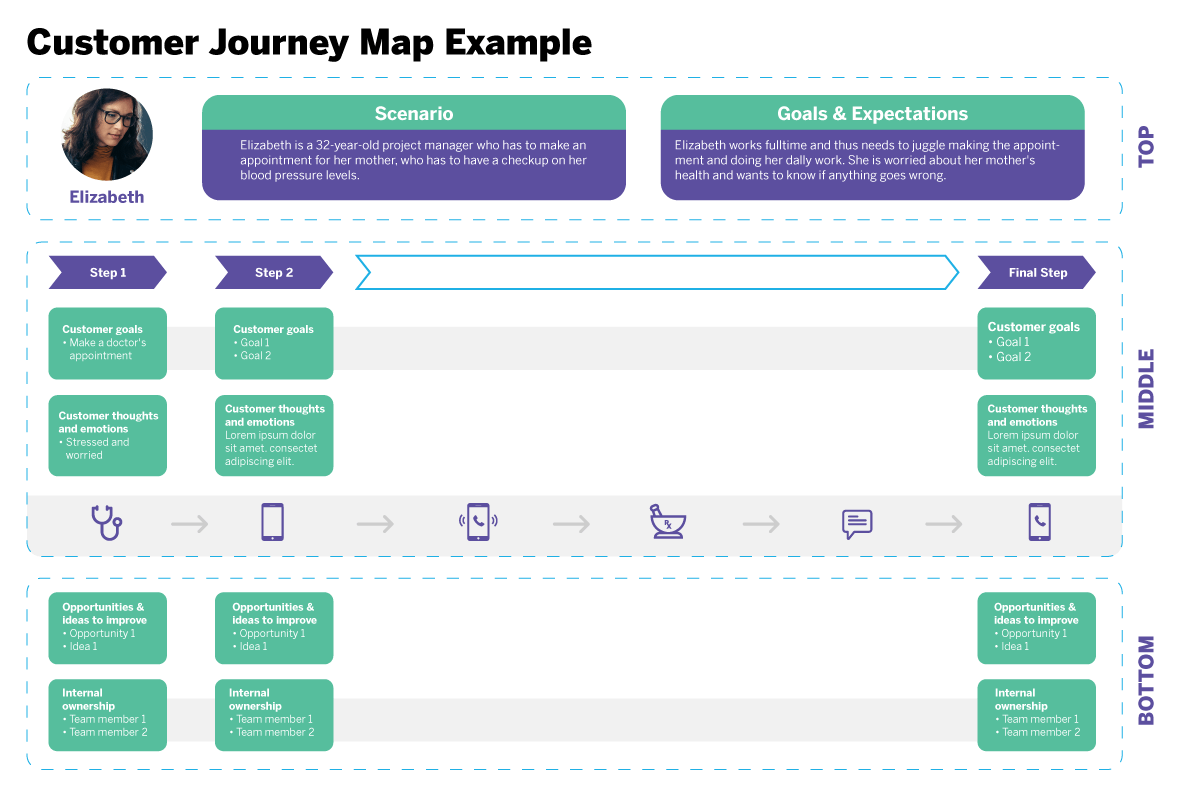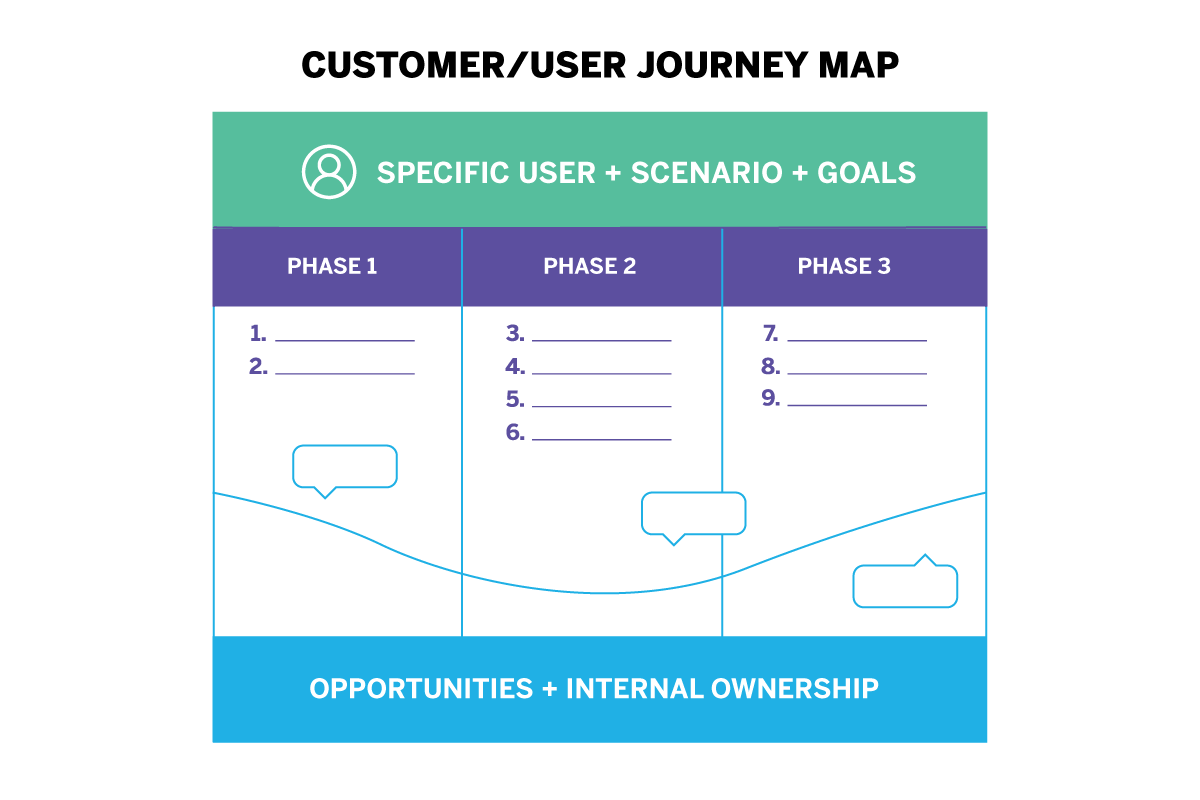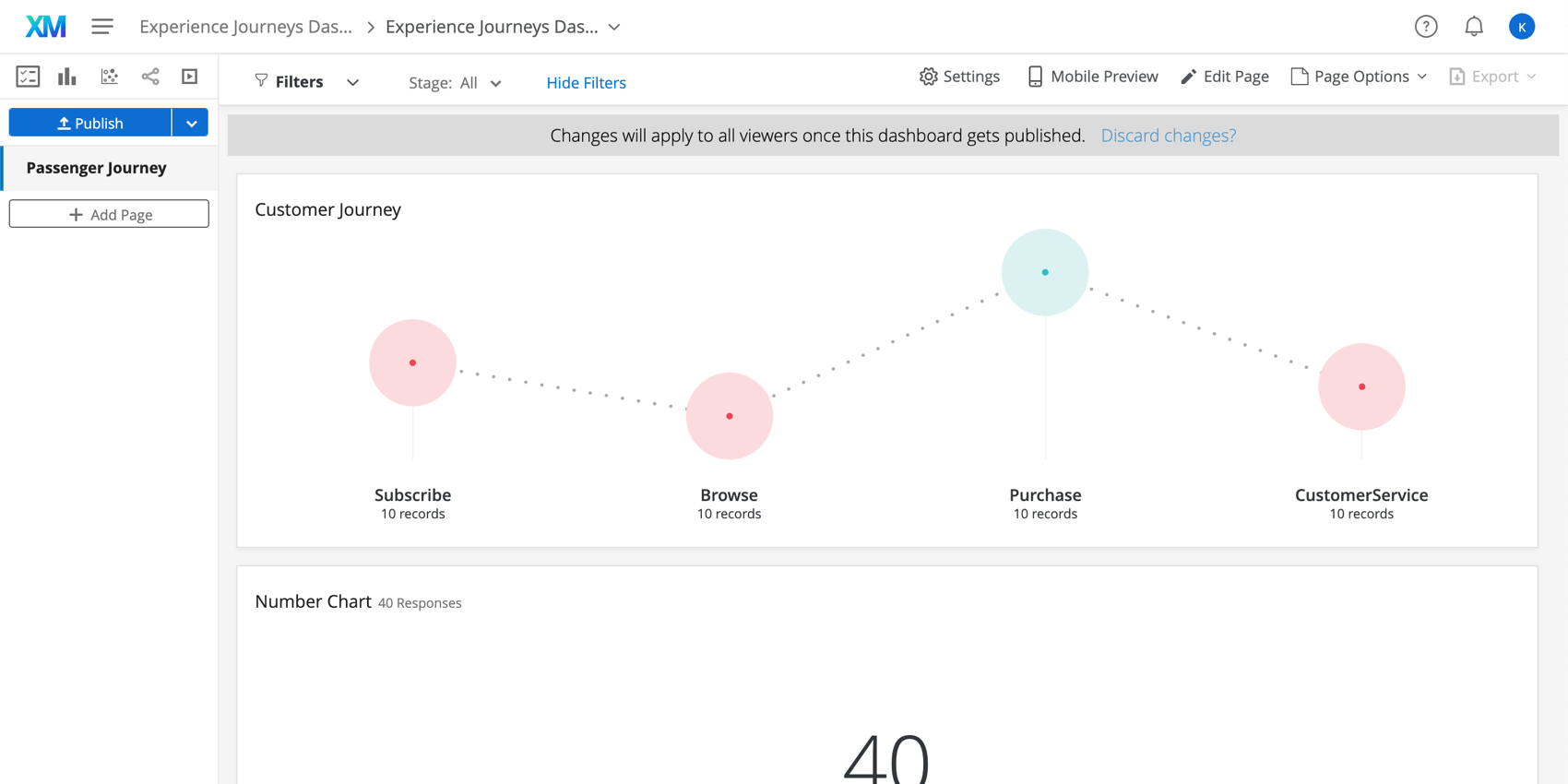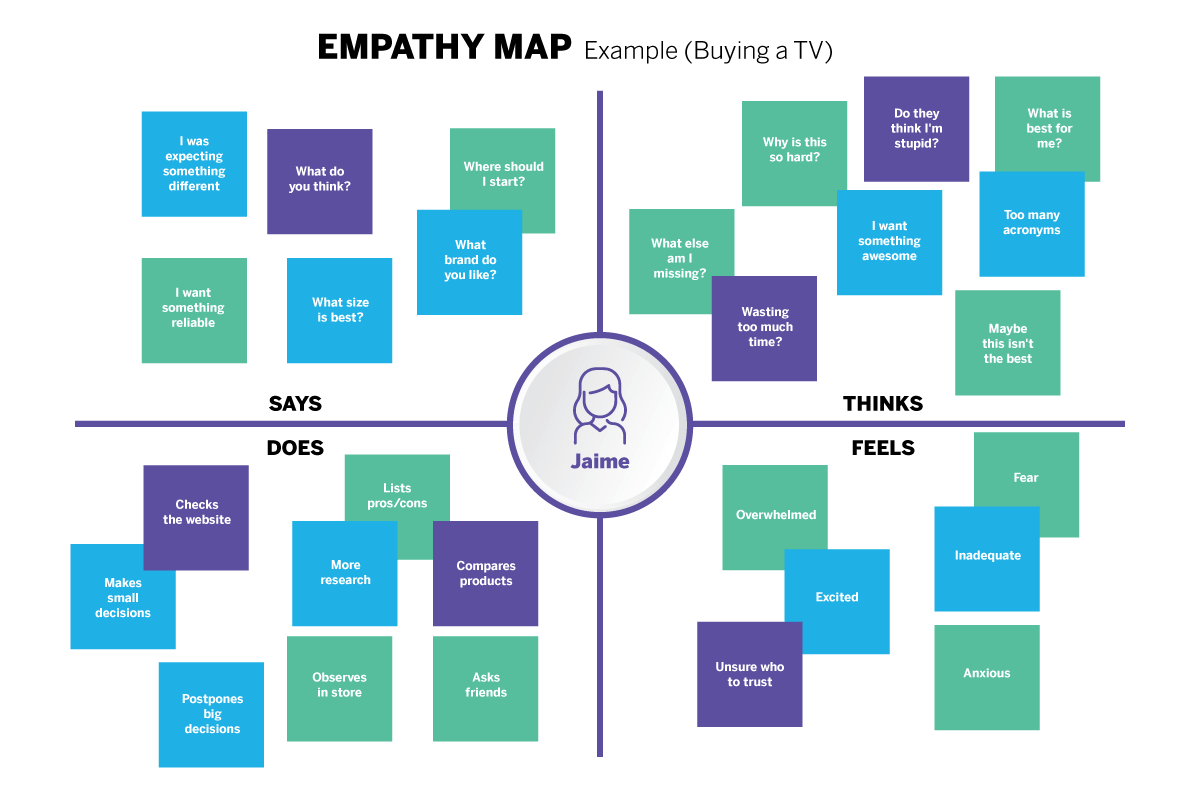What is user journey mapping?
A user journey map is a visual representation of what a user must do to achieve a goal, and outlines the experience they have with your brand. Their goal might be to complete a purchase, find information, or sign up to a service. Whatever the user’s goal is, a journey map can help businesses to figure out where there are pain points and improve the user or customer experience.
A journey map is best used for outlining complex journeys that involve either multiple events, a particular process with several stages, or involve more than one channel. User journey maps can help to clarify these complicated journeys and ensure that the process is smooth and fulfilling for everyone.
Free eBook: The ultimate guide to customer journey mapping

A user journey map / UX journey map vs a customer journey map
Sometimes, the phrases “user journey mapping” or “UX journey mapping are used interchangeably with “customer journey mapping”. In most cases, this is accurate – the users of your website are your customers, so creating a customer journey map will effectively be a UX journey map. However, this doesn’t cover all scenarios. For example:
Customer journey maps don’t cover all users
Customer journey maps are useful for understanding the customer experience you offer, but what if your users aren’t customers? Internal and external stakeholders, researchers, employees, and more might need to find information on your website, even though they’re not customers.
Customer journey mapping is usually tied to a financial goal
Customer journey mapping usually has a financial goal, with a monetary transaction at the end of it (even if the initial goal isn’t, such as a free sign up to a service). A user journey map doesn’t necessarily tie into financial goals – it might be to provide information, for example.
UX journey maps are usually for UX design thinking
A customer journey map is a tool that can be used for many different areas of business – sales journeys, marketing journeys and more can be mapped out. However, a UX journey map is usually used for the UX design process, and might involve more technical information such as website usage data.
Why is a UX journey map important for business?
Getting the complete picture and a deep understanding of your user or customer journey allows your business to understand where problems lie and where positive action can be taken.
Defining your users’ needs, issues, and the scale of their interactions with your brand gives you the ability to fix pain points and develop new pathways for users that you hadn’t thought of before.
For example, perhaps your business has taken a desktop-first approach, offering a great experience for desktop users at the expense of creating a mobile-responsive design. By creating a user journey map, you might see that your users are actually coming in via mobile searches – and with 58.33% of global users choosing mobile, this is quite likely. Your UX journey map gives you a better idea of how to win over your mobile users and provide them with a better user experience.
Why user experience matters
Creating a user experience that meets and exceeds expectations allows you to:
- Create positive feelings and a stronger connection with your users. Fully connected users are on average 52% more valuable than users that are highly satisfied. By offering a positive, connective experience, you can reap the benefits.
- Develop loyal users who return time and time again. With 88% of online users being less likely to return to a website after a bad user experience, it’s important to cultivate loyalty by understanding where your user journeys are failing to impress.
- Invest in your business with a proven ROI. According to Forrester, every dollar invested in UX brings $100 in return on average, an ROI of 9,900%.
- Stand out from the competition. Your journey map might not be too different from a competitor’s – but what will make you stand out is the exceeding of the usual expectations at each stage of the user or customer experience.
Building out a journey map or multiple journey maps for your users allows you to create a deeper relationship with your audience, enabling them to have an intuitive, cohesive experience with your brand.
Components of a thorough user journey map
There are several key elements of a user journey map that are vital for creating an effective service blueprint. You can get started with our basic customer journey map template here, or read on for a more in-depth approach.

1. The specific user
You will likely create a variety of user journey maps. Each one will require you to focus on a specific user and their journey through the assets you’ve created.
Your specific user for each journey map will usually tie into a customer persona. Your user persona should be based on data you’ve collected about your business, such as who is buying your products, has a stake in your business, or is employed by you.
For example, you might have a user who is a senior team member in your business, and a user who is a new employee – both might need different journey maps.
2. The scenario and the goals
On journey maps, the scenario is the situation that the user finds themselves in, with a specific goal in mind. For example, say your user is a customer – the scenario might be that they’re buying a product, with the goal of completing a transaction.
You don’t have to create a user journey map for an existing scenario or goal – perhaps you’re looking to map out a process that’s in the works for a future product launch.
3. User journey stages or phases
Your user journey map is now broken down into stages or phases. This is the high-level view of your user’s scenario, broken down into individual interactions or customer touch points.
For example, if you were selling a product to a customer to fix a particular problem, your stages might be the following:
4. Actions, attitudes and emotions
Within each user journey stage, you will need to map out the actions a user will take; their mindset or attitude toward this journey stage; and the user’s emotional state.
For example, for the “Discovery” phase in the product sale example above, you might note:
- Actions: Use online search engine to find information, visit website, read blog article
- Attitude: Searching for help for a problem
- Emotions: Frustrated with the problem they’re trying to solve, happy at potentially finding a solution
5. Opportunities
When you’ve mapped out the above on your user journey map or customer journey map, you’ll start to see where you have the opportunity to create change. For example, perhaps you’ve seen that you lose lots of users at the Purchase stage. Is there a problem with your purchase system? What incentive could you offer to get users over the hurdle?
Ask yourself:
- What can you do with the knowledge you’ve gained from this journey map?
- What are the main opportunities that should be tackled first for the best ROI?
6. Internal ownership
Once you’ve identified the opportunities, you can then assign internal ownership. Without assigning specific actions and responsibilities, improving your customer experience or user experience can easily fall under the radar.
Your customer journeys or user journeys outlined in your journey map might touch upon multiple parts of your organization. For example, the customer journey outlined in this example involves product design, marketing, sales and frontline customer service departments. Each area of your business will need to take action for the best user or customer experience.
7. Measurement
To understand how your user journey has improved, you’ll need to determine the metrics each improvement will be judged against. This might be customer satisfaction (CSAT), sales numbers, Net Promoter Scores (NPS), or positive user reviews – whichever you feel best represents an improvement for your users’ experience. It’s best to create KPIs to track over time to see how your actions contribute towards tangible change in the user experience.
How to build a user journey map
Now you understand how to create a customer journey map or user journey map, how do you gather all the data you need to flesh it out?
The main sources of useful information will be:
- User/customer research, such as market research
- Unsolicited user data, such as web traffic numbers or social media listening data
- Solicited user data, such as data from user interviews or customer surveys
- Operational data, such as financial transaction data
Qualitative UX research
Qualitative user research helps you to understand the “why” behind user’s actions. How was your customer feeling in the moment when they interacted with you? Which emotion drove them to move into the next phase of your user journey map?
This type of user research involves collecting non-numerical data, such as opinions or feelings. To do this, you might decide to:
- Host user interviews/customer interviews to discover pain points and understand the drivers behind users and customers’ experience
- Perform user research through surveys to gather information on experiences at all user and customer touchpoints
- Conduct research to understand why specific demographics might act in a specific way during their user journey
- Observe users in action, either in person or through screen recordings, to get contextual information on what happens during the journey
- Create an empathy map, outlining what a user says, thinks, does and feels, for each stage of the user or customer journey
Quantitative UX research
Quantitative user research is a more structured approach to gathering user information for your journey map. Rather than the “why” behind your user or customer’s experience, it illustrates the “what.” What are your users doing? How often are they doing it? How much do they spend on it?
- Get insights from internal data to understand actions, such as what happens during user pain points or how often your customers return for another purchase
- Test the usability and accessibility of your website to understand if there are technical drivers behind actions
- Use user research methods such as mouse heatmaps, funnel analysis, analytics and more to understand user behavior
With all this information, you can then create user personas to help kickstart your user journey mapping and UX design process.
Create effective UX journey maps with Qualtrics
Get a deeper understanding of your users and build better customer experiences with user journey maps, enabled by Qualtrics. Build multiple in-depth user journey maps, populated with your organization’s collated data and third-party inputs, for better UX design and customer experience.

With Qualtrics CustomerXM™, you’ll be able to:
- Outline individual user and customer journeys with input from across your business
- Automatically surface emotions, drivers and sentiments in unsolicited and solicited data with iQ™
- Deliver insights and actions automatically to key parties within your organization to enable positive change
- Create UX designs that meet and exceed user expectations
Free eBook: The ultimate guide to customer journey mapping
